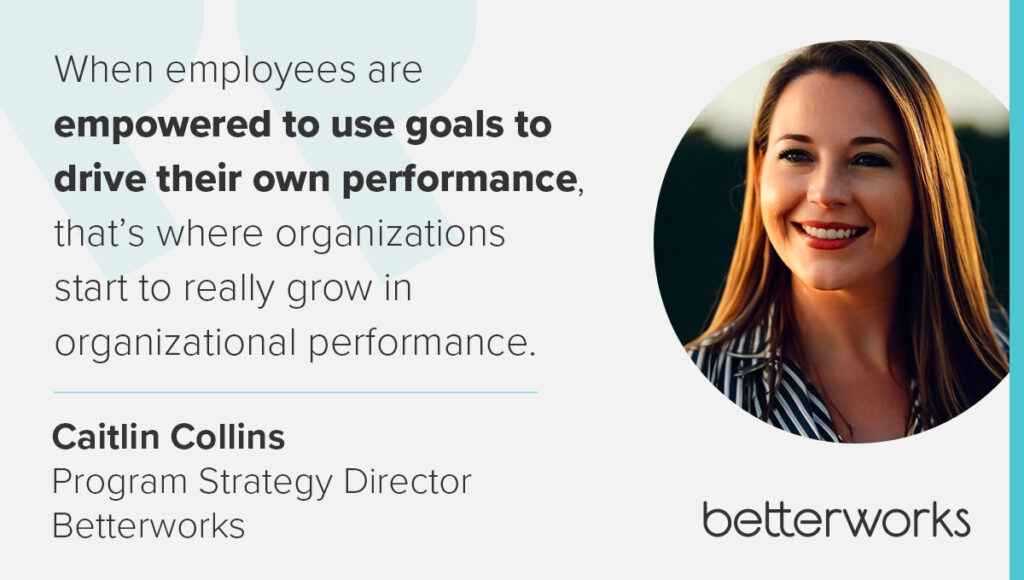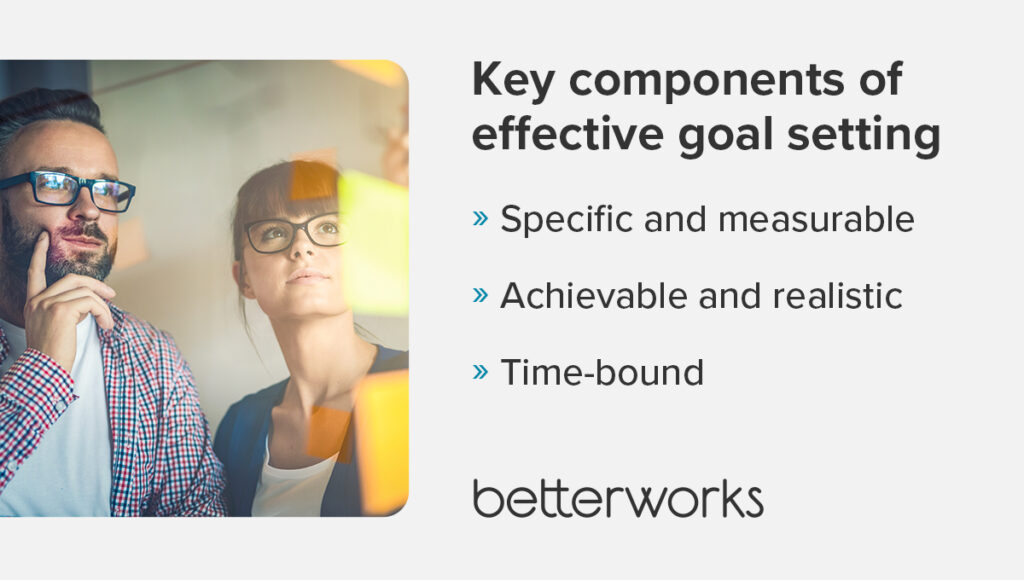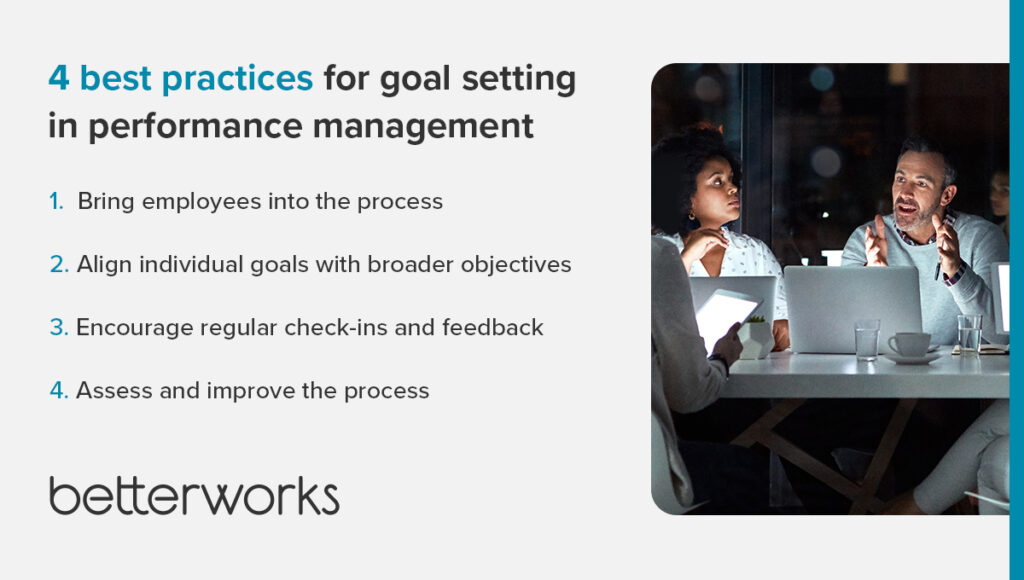- Understanding performance management and goal setting
- Key components of effective goal setting
- 15 examples of effective goal setting
- Customer service representative: improve customer satisfaction
- Sales manager: increase sales revenue
- Marketing manager: improve lead qualification
- Product manager: launch new product
- HR manager: improve employee retention
- Software developer: enhance system performance
- Financial analyst: optimize budgeting
- Operations manager: streamline processes
- Customer support lead: enhance response times
- Content writer: increase website traffic
- Sales representative: improve conversion rates
- UX designer: improve user experience
- Project manager: deliver projects on time
- Training coordinator: enhance employee skills
- IT support: reduce technical issues
- 4 best practices for goal setting in performance management
- Enhance performance management with goal setting
Performance management goals enable business growth by guiding individual contributions toward unified, strategic objectives. No matter how talented your workforce is, employees need clear goals to apply their energy and efforts most effectively.
Employees recognize the difference in their performance when they have business-aligned goals. Our 2024 State of Performance Enablement report reveals that when employees feel that their individual goals align with business objectives, they’re 35% more efficient and productive. “When employees are empowered to use goals to drive their own performance, that’s where organizations start to really grow in organizational performance,” says Caitlin Collins, organizational psychologist and program strategy director at Betterworks.
But despite the impact on business outcomes, many organizations struggle with setting performance goals that align individual contributions with business priorities.
Check out these employee performance goal examples and best practices to inspire more effective performance management goals in your organization.

Understanding performance management and goal setting
Performance management is a dynamic process designed to help you align individual performance with your organization’s strategic planning and objectives. It goes beyond annual reviews, creating a continuous feedback loop where managers and employees collaborate to set, track, and achieve goals. This system empowers members of your workforce to understand their contributions to the bigger picture, fostering engagement and driving high performance across all levels of your organization.
Goal setting is a cornerstone of effective performance management. Setting clear, measurable objectives provides your team with a roadmap to success. Regular check-ins and real-time feedback ensure that everyone stays on track, addressing challenges and celebrating wins along the way. This approach not only enhances productivity but also cultivates a culture of accountability and growth.

Key components of effective goal setting
Goals need to be clear, actionable, and measurable for employees to accomplish them. The SMART goals model, which is one of the most popular, calls for goals to be specific, measurable, achievable, realistic, and time-bound, and provides a blueprint for setting effective objectives. Check out some of the ways the SMART goals model helps you set more effective performance management goals and objectives.
Specific and measurable
Specific goals provide clarity about what employees are working toward and keep everyone moving in the right direction. Clearly defined goals also provide teams and individuals with a concrete understanding of how to measure success. This clarity helps remove ambiguity and aligns everyone’s efforts to the same targets.
Measuring progress allows employees and managers to track performance and identify areas that need improvement, enabling managers to provide timely feedback and helping team members make adjustments to keep everyone on course. Regularly reviewing these metrics — and adjusting if needed to reflect changing priorities — helps teams celebrate everyday wins to remain motivated and engaged.
Achievable and realistic
When managers establish targets that are within reach, they help their team build confidence and momentum. Goals that are too ambitious can lead to frustration and burnout, negatively impacting morale and performance. That’s why setting achievable and realistic goals supports performance enablement and generates a positive work environment where employees feel like they can make a tangible difference.
Achievable goals also allow for steady progress. When your team meets its targets, employees experience a sense of accomplishment, which boosts their engagement and encourages them to tackle new challenges. Consider employees’ current workload, skills, and resources when setting goals. This approach helps prevent overwhelm so the team can focus on delivering high-quality results.
Time-bound
Setting time-bound goals is crucial for maintaining team focus. Attaching a deadline to a goal creates a sense of urgency that drives action. This helps your employees prioritize their tasks and manage their time effectively. Clear timelines keep everyone on track and prevent projects from dragging on indefinitely.
Time-bound goals also provide a framework for regular check-ins and progress reviews. These milestones allow teams and individuals to celebrate achievements and address any obstacles promptly. Setting a time frame ensures the team remains focused and motivated, working steadily towards completing objectives. This structured approach not only enhances productivity but also fosters a culture of accountability and efficiency. Incorporating Just in Time Access to necessary tools and information ensures that employees can efficiently meet their goals without delays, further enhancing productivity and engagement.

15 examples of effective goal setting
Sharing employee performance review goal examples allows you to communicate ideas individual employees can apply when considering their own performance and professional development goals. To power your performance management program, consider these performance management goal-setting examples to understand what makes a goal effective. Adding three to five measurable actions to achieve each will detail “how” the goal will be achieved. Each of these examples can also be potentially aligned with skill development or improvement, as explained below.
Customer service representative: improve customer satisfaction
A Customer Service Representative might aim to achieve an average customer satisfaction rating of 4.8 out of 5 within the next quarter. This employee performance goal enhances overall customer experience and retention while providing a clear, measurable target. This goal could improve customer interaction, customer onboarding experiences, and problem-solving skills.
Sales manager: increase sales revenue
For a Sales Manager, increasing monthly sales revenue by 20% over the next six months boosts company profitability and market share. This goal encourages strategic planning and performance tracking, enhancing sales skills.
Marketing manager: improve lead qualification
A Marketing Manager could revamp the lead qualification process to move 50% of leads generated in Q2 from SS0 to SS1, enhancing their skills in targeting and conversion.
Product manager: launch new product
A Product Manager might aim to launch a new product by the end of Q3 with a 95% on-time delivery rate, expanding the product portfolio and market presence while personally improving project management and collaboration skills.
HR manager: improve employee retention
An HR Manager could work to reduce the employee turnover rate by 10% over the next year through enhanced engagement programs, maintaining a stable and motivated workforce. This performance management goal focuses on creating a positive work environment, which can improve job satisfaction and engagement. Such a goal requires analytical and planning skills.
Software developer: enhance system performance
For a Software Developer, reducing system downtime by 50% within the next six months improves operational efficiency and customer satisfaction. This effort advances problem-solving and the development of technical skills.
Financial analyst: optimize budgeting
A Financial Analyst might identify and implement cost-saving measures totaling $500,000 by year-end, improving financial health and profitability. This goal enhances analytical skills and financial acumen.
Operations manager: streamline processes
An Operations Manager could decrease production cycle time by 15% within the next two quarters, increasing operational efficiency and output. This goal requires process optimization and management skills.
Customer support lead: enhance response times
A Customer Support Lead might aim to reduce the average customer support response time to under two hours within the next quarter, elevating customer service standards and satisfaction while improving time management and responsiveness. Pursuing this goal could build analytical capabilities, project planning, and training skills.
Content writer: increase website traffic
A Content Writer could publish 12 high-quality blog posts per month, increasing website traffic by 25% over six months, driving brand awareness and lead generation, which might enhance writing, SEO analysis, content marketing, and time management skills.
Sales representative: improve conversion rates
A Sales Representative might aim to achieve a 30% sales conversion rate within the next quarter, enhancing sales effectiveness and revenue growth. This goal requires a focus on improving sales techniques, customer engagement skills, and tracking SDR metrics to optimize performance and identify areas for improvement.
UX designer: improve user experience
A UX Designer could increase the average session duration on the website by 20% over the next six months, boosting customer engagement and satisfaction while further developing their analytical, design, and user experience skills.
Project manager: deliver projects on time
A Project Manager might aim to ensure 95% of projects are completed on time over the next year, improving project efficiency and client satisfaction. This goal would sharpen project management and organizational skills.
Training coordinator: enhance employee skills
A Training Coordinator could conduct eight training sessions per quarter, increasing overall employee skill ratings by 15%. This would cultivate a skilled and capable workforce while providing opportunities for professional growth and skill enhancement.
IT support: reduce technical issues
An IT Support specialist might resolve 90% of IT support tickets within 24 hours over the next quarter, maintaining smooth and efficient business operations. This goal could strengthen prioritization, organizational, problem-solving, and technical support skills.
4 best practices for goal setting in performance management
To maximize the impact of performance management goals, you need to make sure they’re both realistic and motivating. By focusing on effective goal-setting best practices and techniques, you can drive performance, boost morale, and ultimately contribute to the overall success of your organization.
Bring employees into the process
Standard models of performance management cascade goals set at the top down to each level beneath it, but employees aren’t likely to be motivated by receiving a list of performance goals set at the top. “If we assign goals to people that they don’t really care about, you’ll decrease engagement and motivation,” Caitlin says.
Involving employees in setting their own goals is crucial for fostering buy-in and commitment. When you actively engage your team in setting their own goals, you give them a sense of ownership and responsibility. This participation helps them understand the “why” behind each objective, making them more invested in achieving it. Employees are more likely to commit to goals they have had a hand in creating because they feel their input and perspectives are valued.
Additionally, involving employees and managers in goal-setting can uncover valuable insights and innovative ideas. Your team members often have a deep understanding of their roles and can provide practical suggestions that enhance the impact of goal setting. This collaborative approach not only strengthens their commitment but also improves the relevance and attainability of the objectives.
Align individual goals with broader objectives
When employees understand the big picture, they can see how their individual efforts contribute to the overall success of the company. Start by clearly communicating the organization’s vision and long-term goals to your team.
Break down these overarching goals into smaller, more manageable objectives that align with each team member’s role and responsibilities. During goal-setting discussions, connect each person’s goals to the company’s strategic objectives. This ensures that everyone’s efforts are directed toward the same outcomes, creating a unified approach.
For example, if one of the organization’s goals is to enhance customer satisfaction, a sales team member’s goal might be to improve their customer follow-up process, while a product development team member might focus on incorporating customer feedback into new features. Aligning individual goals with the broader objective underscores the importance of goal setting, and guarantees that all employee work supports the company’s strategic direction.
Review and adjust goals regularly to stay aligned with any changes in organizational priorities. This ongoing alignment not only supports coherence but also nurtures a sense of purpose among employees. They can see the direct impact of their work on the company’s success, which boosts motivation and engagement.
Encourage regular check-ins and feedback
Regular check-ins and feedback between managers and employees help teams track progress and make necessary adjustments. Consistent meetings with team members keep everyone aligned and enable managers to address any challenges promptly. These check-ins provide a structured opportunity to discuss progress, celebrate achievements, and identify any obstacles that might hinder success.
Providing ongoing feedback during these sessions is crucial. It helps employees understand how their efforts contribute to the broader objectives and what areas might need improvement. This real-time insight allows for timely adjustments. Continuous performance management and constructive feedback not only keep your team on track but also build a culture of ongoing improvement. This proactive approach enhances overall performance and helps your team feel supported and engaged in their work.
Assess and improve the process
Continuously improving the goal-setting process requires a proactive approach, leveraging feedback and data. Start by regularly soliciting input from your team about the goals and the process itself. Ask for their thoughts on what’s working and what could be improved. This feedback provides valuable insights that can help you refine and adjust your approach.
Analyze performance data to identify trends and areas for improvement. Look at metrics such as goal achievement rates, timeframes, and the resources used. Use this data to pinpoint any patterns or recurring issues that need addressing. For instance, if you notice certain goals are consistently not being met, investigate why and consider making adjustments to make them more realistic or provide additional support. This is where using advanced analytics can help you uncover, weaknesses, trends, and patterns.
Incorporate these insights into your goal-setting process by revising goals to be more specific, measurable, and achievable. Regularly update your strategies based on what the data and feedback reveal. Encourage a culture of openness where employees feel comfortable sharing their experiences and suggestions.
By actively involving your team and using data to inform your decisions, you create a dynamic and effective goal-setting process. This approach not only helps in setting better goals but also ensures that your team remains motivated and aligned with the organization’s objectives.

Enhance performance management with goal setting
At the heart of performance management, performance goals provide employees with a clear path to success. Setting SMART goals is one approach for eliminating ambiguity and enables employees to understand exactly what is expected of them. This clarity not only boosts motivation and commitment but also cultivates a culture of accountability and growth.
Betterworks plays a pivotal role in enhancing performance management goal setting through a comprehensive goal alignment software solution. The Betterworks platform facilitates the creation and tracking of measurable goals, supports regular check-ins, and provides real-time feedback, guaranteeing that teams remain aligned and can make necessary adjustments promptly.
Using Betterworks, you can develop and implement goal-setting processes that are efficient, data-driven, and conducive to continuous improvement — ultimately driving both individual and organizational success.
Want to learn more? Find out how OKR software drives business results.
The link between goal setting and retention


